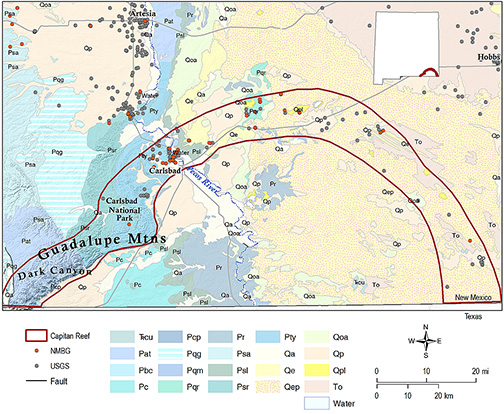
Overview of Fresh and Brackish Water Quality - Capitan Reef


The Capitan Reef is a fossil limestone reef of middle Permian age that is dramatically exposed along the southeast flank of the Guadalupe Mountains in Eddy County, New Mexico, reaching its maximum elevation in west Texas, in Guadalupe Mountains National Park. In New Mexico, the reef serves as the host rock for the Big Room in Carlsbad Cavern. A few miles northeast of Carlsbad Caverns National Park, the reef dips into the subsurface and passes beneath the city of Carlsbad, where it forms a karstic aquifer that is the principal source of fresh water for that community (Land and Burger, 2008). The Capitan Reef continues in the subsurface east and south into Lea County, then south for ~150 miles to its southeasternmost outcrop in the Glass Mountains of west Texas.
Recharge to the Reef Aquifer occurs by direct infiltration into outcropping cavernous zones formed in the Capitan limestone and equivalent backreef units of the Artesia Group. A significant component of this recharge occurs during flood events in Dark Canyon in the Guadalupe Mountains, where the reef crops out in the bed of Dark Canyon arroyo. Groundwater flows northeastward through the reef and discharges from springs along the Pecos River within the city of Carlsbad (Bjorklund and Motts, 1959). Evidence of cavernous porosity and conduit flow is well documented within the Reef aquifer, indicated by blowing wells and bit drops during drilling operations; and by the presence of water in channels and cavities at different horizons within the reef (Hendrickson and Jones, 1952; Motts, 1968). Carlsbad Cavern may thus be thought of as an upper end-member example of cavernous porosity development within the Capitan Formation (Land and Burger, 2008).
Fresh water is present in the aquifer only in the immediate vicinity of its recharge area in the Guadalupe Mountains. Mineral content rapidly increases east of the Pecos River, and throughout most of its extent the Capitan Reef is a brine reservoir, with TDS concentrations >100,000 mg/l in some of the deep monitoring wells in Lea County (Hiss, 1975a; 1975b).
The data set for the Capitan Reef aquifer is very limited, consisting of only 13 wells, most of which were last sampled almost half a century ago. The small data set is primarily due to the extremely limited amount of fresh water available in the reef aquifer. The city of Carlsbad, because of its proximity to recharge areas in the Guadalupe Mountains, is the only community in the region that is favorably positioned to exploit the freshwater segment of the reef. Because of the highly saline nature of groundwater in the Capitan Reef east of the Pecos River, very few water supply wells are completed in that portion of the aquifer. Until recently, the only water quality information available for the reef east of the Pecos River was from a network of monitoring wells installed by the U.S. Geological Survey in the mid-20th century (Hiss, 1975a; 1975b). These records confirm the highly mineralized character of groundwater in the eastern segment of the Capitan Reef, resulting in a mean TDS concentration for the entire aquifer of >54,000 mg/l. We have chosen not to plot TDS and specific conductance vs. depth for the Capitan Reef because the lateral distribution of dissolved solids most accurately characterizes the distribution of salinity within this aquifer.
Brackish water resources are clearly available in the Capitan Reef aquifer, although for the most part that water is more accurately described as a brine, and would thus not be suitable for conventional desalination technologies. However, this highly saline water is a valuable resource for industrial applications in southeastern New Mexico and west Texas. Both the petroleum and potash mining industries have recently expressed interest in exploiting brackish water in the reef aquifer for water flooding of mature oil fields in the Permian Basin region and for processing of potash ore.
This project is funded by the New Mexico Environment Department, Drinking Water Bureau, under Source Water Protection.
For more information:
see: Overview of Regional Brackish Water Assessments
or contact:
Lewis Land — Hydrogeologist, lland@nckri.org
References
- Land, Lewis, 2016, Overview of Fresh and Brackish Water Quality in New Mexico - Capitan Reef, Project Summary Sheet.
- Land, Lewis, 2016, Overview of Fresh and Brackish Water Quality in New Mexico, New Mexico Bureau of Geology Mineral Resources, Open-file Report, v. 0583, pp. 55.



